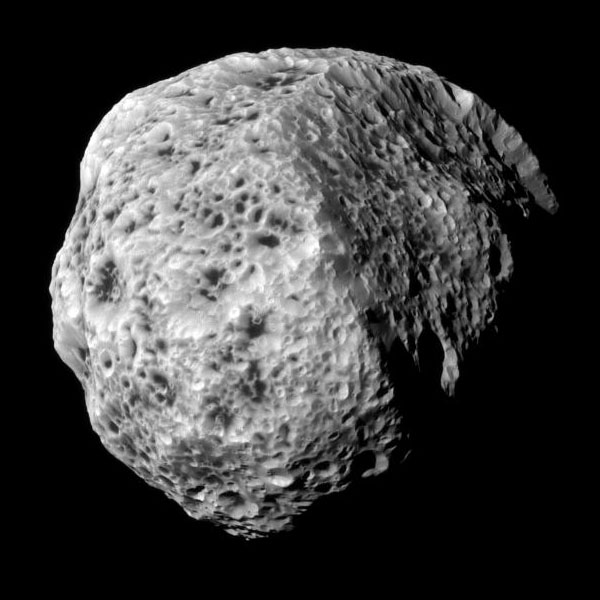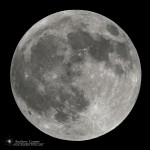This evening a nice crescent Moon will join Venus in the dusky sky. The pair will be reasonably close, about 8° apart. Venus is currently shining very brightly at about -4.1 magnitude, contrasting nicely with a 9% illuminated Moon. The two will still be close tomorrow, about 9° apart with the Moon 15% illuminated.
Tag: Moon
New Moon
Lunar Apogee and Perigee
Does the Moon seem a little larger and brighter than usual? It may not be an illusion, sometimes the Moon really does look a little larger or smaller in the sky.
Like all orbiting objects, the Moon does not orbit in a perfect circle, but rather in an ellipse. This means that as it orbits it is a little further away or a little closer. In the case of the Moon the difference is not much, but you can see it, if you know to look.

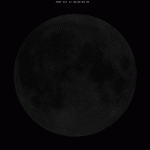
The period of time between full Moons, the synodic month, is about 29.5 days. While lunar perigee occurs every 27.5 days, an anomalistic month. Since these periods are not equal, the cycle drifts in and out of phase. About once a year the cycles coincide and full Moon and apogee or perigee will occur near the same time.
At apogee, the Moon will be appear about 29 arc-minutes in size, a little less than half a degree. At perigee the Moon will be about 33 arc-minutes across, a bit more than half a degree. The numbers may not seem like much, but it is a visible difference. The simulated images shown here will give a better idea of what the numbers represent.
This change in size and distance leads to the moonlight being a bit brighter at perigee than at apogee, about a 30% difference. So if that moonlit night seems brighter than you remember it may actually be the case.
Laser Return Photometery
A different use for amateur astrophotography gear.
An amateur CCD camera can do more than take pretty pictures. There is no reason why any decent telescope, however small, and a CCD camera can not be used to do real science, or real engineering in this case.
The goal of the night was to perform proper photometry on the laser returns with independent equipment. We want to quantify the performance of the Keck adaptive optics laser systems. We launch two powerful lasers into the sky, one from each telescope, to allow analysis of the atmospheric distortions through which the telescope is observing. Using the data the system can correct for this atmospheric distortion and create much sharper images of distant stars and galaxies.
The lasers pass through a layer of sodium atoms about 90km (55miles) above the ground. There the 589nm yellow light excites these sodium atoms creating a glowing beacon, what we call the laser return. This return is what we look at to analyze atmospheric distortion. A brighter return allows better data and better performance of the system.
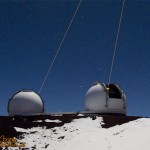
Both the Keck 1 and Keck 2 lasers in operation under the light of a nearly full Moon
Amateur astrophotography gear is perfectly capable of doing this task. A portable telescope, a proper CCD camera, combined with care to acquire calibrated images. All that I needed to add to the setup was a photometric V filter.
It was a perfect night for it, clear, dry and cold. Best of all, there was no wind to bounce the telescope around and chill anyone working outside. The winds are nearly constant atop at 14,000ft peak, calm nights are unusual, I was lucky indeed.
I setup the telescope atop a crust of ice and snow. The snow was convenient as it allowed me to set down gear on a cleaner surface than the gritty volcanic cinder underneath, keeping everything quite a bit cleaner. The altitude and cold made setup and breakdown a slow, laborious process, and added unique difficulties. I had to be very careful moving the heavy gear, so as not to slip on the icy snow. When I went to move the telescope tripod I found it frozen into the snow and cinder! I had to heave hard to break it free.
Full Moon
The Moon and Pleiades
Tonight a bright gibbous Moon will be just under 3° from the Pleiades star cluster. The Moon will be 84% illuminated, bright, but the cluster is bright enough to be seen even against a bright Moon. As the Pleiades move to the west over coming months there will be a few more lunar conjunctions, with increasingly smaller crescents.
The Moon and Jupiter
Tonight the Moon and Jupiter will shine brightly high in the evening sky. The pair will be about 5°55′ apart near zenith as the sky grows dark.
The Moon and Jupiter
Tonight the Moon and Jupiter will dominate the evening sky. They will be close to each other, about 9°40′ apart. The Moon will be a little over 60% illuminated, with Jupiter shining brightly at -2.6 magnitude. Tomorrow they will be even closer, at only 6° separation.
Postcard from the Universe – Moon and Venus
Last night the Moon and Venus were a mere 2.5° apart. I tried to look for the pair after sunset, but all I was able to see was a dim glow in the clouds. My friend Maureen was luckier, she was able to catch the pair through a gap in the clouds while the same clouds were lit up by the sunset. I am just a little jealous…
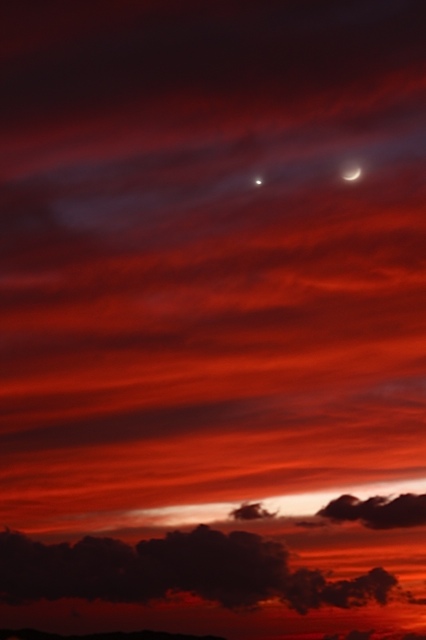
Postcard from the Universe – Hyperion
One of my favorite moons in the solar system has to be Hyperion. This small icy body is one of those truly weird places.
An oblong shape roughly 360 x 200km (220 x 120miles) the moon is composed of primarily water ice with a small amount of rock in the mix. The moon is thought to be highly porous, a loosely held together rubble pile perhaps. This is indicated by the odd appearance of the many impact craters, looking as if the impacting body is absorbed as much as vaporized. The material of the crater walls then slumping back into the void.
